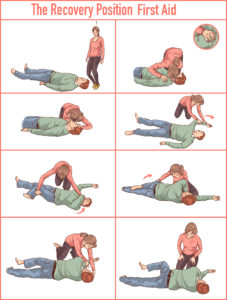 The Recovery Position is a way of placing the patient into a more safe and secure position. The Recovery Position allows you to monitor the patient easily and also negates the risk of them choking on anything.
The Recovery Position is a way of placing the patient into a more safe and secure position. The Recovery Position allows you to monitor the patient easily and also negates the risk of them choking on anything.
Use of Recovery Position
After carrying out a primary survey, you will be able to tell if the patient is conscious or unconscious, and breathing or not breathing. Should the patient be unconscious and not breathing, then CPR (Cardiopulmonary Resuscitation) should be taken out. If they are conscious but not breathing then they will probably be choking, so work on removing the blockage as quickly as possible.
If no major problems are present, then most situations would call for the position. The patient does not have to be unconscious to be put into the recovery position. It can be just as helpful for the patient to be in the recovery position if they are conscious.
Other Positions
Sometimes the normal Recovery Position would not be appropriate. If there is a suspected spinal injury, the last thing you want to do is to twist their spine. Therefore there is a different manoeuvre to maintain C-Spine Immobilisation. This is called the Spinal Recovery Position. The position that the patient ends up in is the same as with the normal Recovery Position. However, the manoeuvre keeps the spine straight and still, preventing causing further injury.
If the patient is suspected to be having a heart attack, again, the Recovery Position would not be suitable. Get the patient to sit down against something flat and sturdy and offer them an aspirin. Once they have sat down, make sure they are sitting as upright as possible, and tell them to bring their knees towards their chest. Not all the way so they are touching their chest, but just enough to make the shape of a ‘W’. Hence, this is called the ‘W’ position. It helps to relieve stress on the heart and lungs, aiding pain relief.
In the Recovery Position
Once they are in the position, make sure that they are still breathing. If they stop breathing for at least 10 seconds, start CPR immediately. If they are stable once on their side, position the head so that the mouth is slightly open. Make sure that the airway is open and their head is resting on their hand. Keep going back to make sure that they are breathing. If you are on your own, you must go and call the emergency services. As they are in the Recovery Position, they should be relatively safe whilst you make the call. If there is somebody else there, you can send them to call the emergency services as soon as possible if required.
Your job now as a first aider is to care for them. If you can, cover them with a blanket to keep them warm. Keep monitoring their vital signs, and just listen and talk to them. You want to try communicating as much as you can with the patient. If you send someone to go and get help, tell them to come back. When they come back, find out what they say so you know when the emergency services are going to arrive.
This page does not explicitly tell you how to put someone into the recovery position as it is advised that you have gone through proper training and practice before doing any First Aid.
For more information on training courses, visit our “Courses” page which also includes our First Responder and First Person on Scene (FPOS) Courses.

Pingback: Why Learn First Aid, hear the answer from a paramedic
Pingback: Spinal Recovery Position - First Aid Wiki